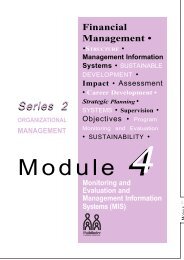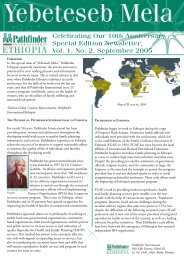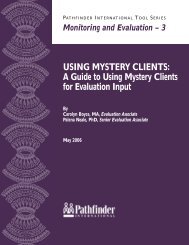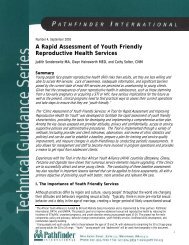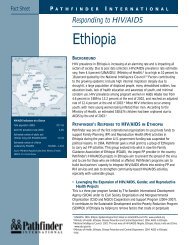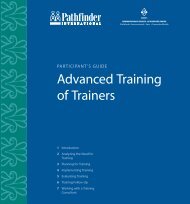Advanced Training of Trainers - Pathfinder International
Advanced Training of Trainers - Pathfinder International
Advanced Training of Trainers - Pathfinder International
You also want an ePaper? Increase the reach of your titles
YUMPU automatically turns print PDFs into web optimized ePapers that Google loves.
d) Specific cases should be pointed out with the client’s name to help participants internalize<br />
the points.<br />
8. Clinical training sites should be selected based on the following criteria:<br />
a) Fancy, modern equipment is available.<br />
b) Staff are trained to give support to the trainees.<br />
c) It is very close to the participants’ dormitory.<br />
d) The use <strong>of</strong> protocols reflect the knowledge and skills covered in the<br />
training.<br />
9. The following are objectives <strong>of</strong> training follow-up except:<br />
a) Providing feedback on the shortage <strong>of</strong> trainees.<br />
b) Improving the quality <strong>of</strong> services.<br />
c) Providing trainees with further knowledge.<br />
d) Ensuring that the trainees are applying the things they learned.<br />
10. During training follow-up the trainer can determine whether the trainee is providing the<br />
service he or she was trained for by:<br />
a) Reviewing the log books to assess the type and mix <strong>of</strong> clients the<br />
trainee is seeing.<br />
b) Interviewing clients to see if they are satisfied with the <strong>of</strong> service provided by the trainee.<br />
c) Evaluating the facility infrastructure.<br />
d) Developing a checklist with the skills learned during the training program and writing in<br />
the number <strong>of</strong> times the trainee has practiced each skill following the training course.<br />
11. There are 4 levels in the most widely-used model to evaluate training. The third level measures:<br />
a) Reaction: Did the participants like the training?<br />
b) Behavior: Are the participants performing differently?<br />
c) Learning: What knowledge or skills did the participants retain?<br />
e) Results: What is the impact <strong>of</strong> training?<br />
12. The disadvantages <strong>of</strong> objective tests (multiple choice, matching, true/false, fill-in) are:<br />
a) They are difficult to write.<br />
b) They are time consuming to write.<br />
c) Grading is time consuming.<br />
d) They are subjective and open to interpretation.<br />
13. A level 1 training evaluation can be used to measure all <strong>of</strong> the following EXCEPT:<br />
a) Learning<br />
b) Change in attitude or beliefs<br />
c) Customer or trainee satisfaction<br />
d) The trainer’s knowledge<br />
122





